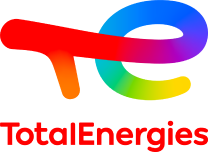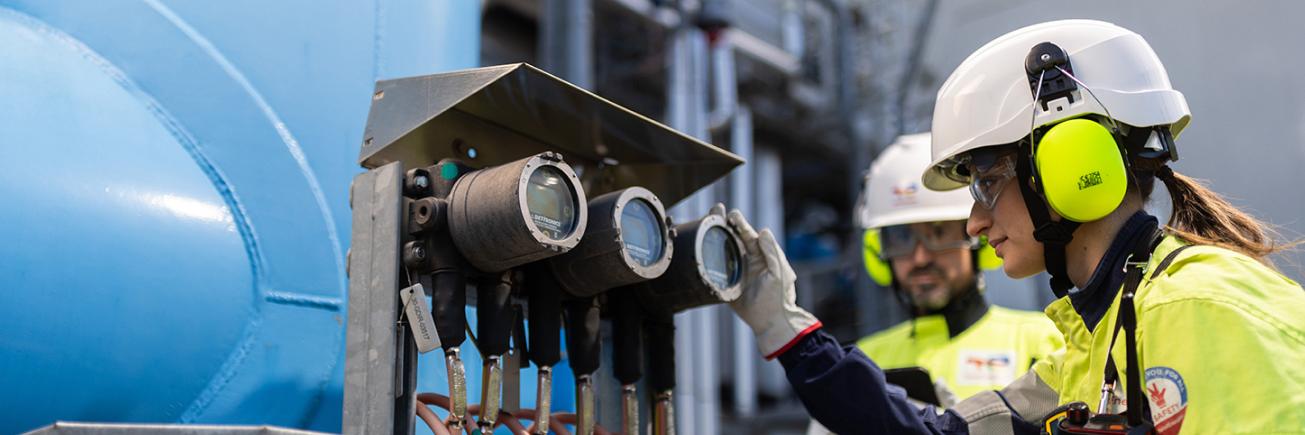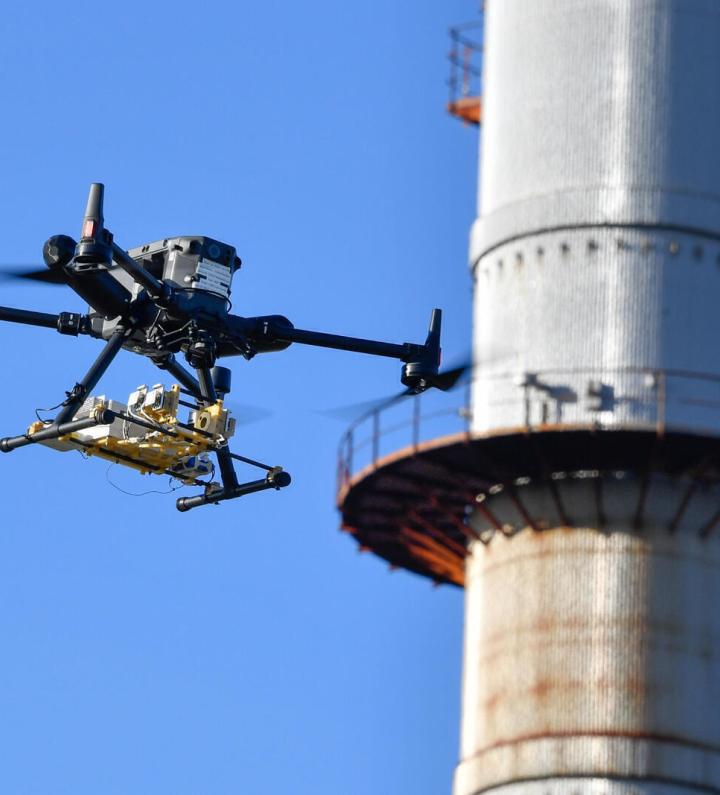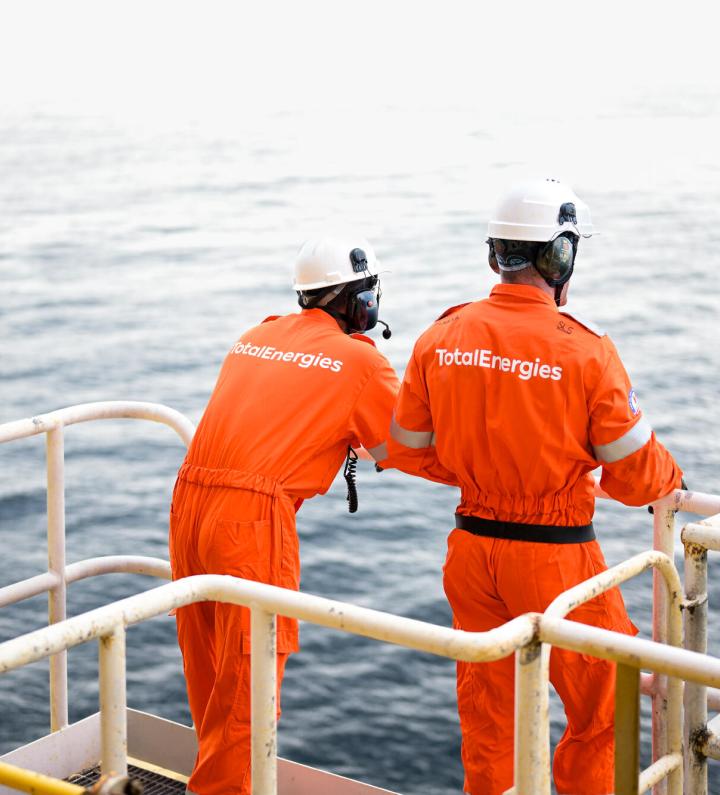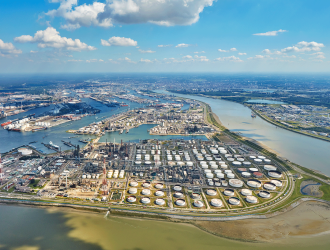Reducing Our Direct Emissions
Reducing our Direct Emissions
Reducing our Direct Emissions
All fossil energy producers must make reducing their direct greenhouse gas emissions a top priority. At TotalEnergies, we pursue this goal with steadfast determination. Across our operated facilities (Scope 1+2), we aim to achieve carbon neutrality by 2050, with an intermediate target to reduce our net greenhouse gas emissions by 40% by 2030, compared with 2015 levels. This target is consistent with the roadmap set out in the European Union’s “Fit-for-55” package and the IEA’s 2023 Net Zero Emission scenario.
To make this happen, we are deploying cutting-edge technology to stop routine flaring, gradually eliminate methane emissions and improve energy efficiency.
Eliminating routine flaring by 2030
It is essential to put an end to routine flaring in order to reduce our CO2 and methane emissions: we pledged to stop this practice on new projects back in 2000.
As a founding member of the Zero Routine Flaring by 2030 initiative launched in 2015 by the World Bank, we are committed to ending routine flaring by 2030.
Since 2010, we have cut the volume of gas routinely flared by 90% across our operated facilities. We aim to fall below 0.1 Mm3/day by 2025, before eliminating routine flaring altogether by 2030.
Find out how we are working toward achieving zero routine flaring
Aiming for zero methane emissions by 2030
Methane is a greenhouse gas with 28(1) times greater global warming potential than CO2 over a 100-year timescale, making it key to any emission reduction strategy. The oil and gas industry, responsible for a considerable proportion of global methane emissions, must lead the way.
As a driving force in the energy transition, TotalEnergies is fully assuming its leadership role in the fight to collectively reduce methane emissions and has been striving for many years to reduce them. As a result, we successfully halved the volume of methane emissions generated by our operated facilities between 2010 and 2020.
Moreover, we aim to cut these emissions by a further 50% by 2025 and 80% by 2030 compared with 2020 levels. These objectives apply to all Company operations and go beyond the 75% reduction in methane emissions from coal, oil and gas between 2020 and 2030 outlined in the Net Zero Emissions by 2050 scenario published by the International Energy Agency.
In addition, we are bringing our partners at our non-operated facilities on board by sharing feedback and best practice, for example with the Oil and Gas Methane Partnership 2.0 (OGMP 2.0). More generally, we are working with our partners at all our non-operated facilities to encourage them to reduce direct emissions.
In our Exploration & Production business segment, we have created a team responsible for sharing a decarbonization roadmap that usually includes an energy assessment, energy efficiency improvements, the elimination of methane venting and routine flaring.
Find out how we are reducing our methane emissions
Improving energy efficiency
Generating energy savings in our operations is beneficial in several ways: we contribute to the collective campaign for energy efficiency, we help to reduce our carbon emissions and we lower our costs.
To increase the pace of improvements in energy efficiency across our operated facilities, we launched a $1 billion two-year investment plan in September 2022, which seeks to save nearly 2 Mt CO2e a year by 2025, primarily across the oil and gas business segment.
Reducing our emissions with geological CO2 storage
In addition to our emission reduction projects and the initiatives carried out as part of our overall energy efficiency improvement program, we are developing Carbon Capture and Storage (CCS) to deal with a portion of CO2 emissions generated by our assets.
CCS is an effective way to reduce the emissions from our plants, whether we are operator or partner, together with our other efforts in this area.
In Norway, where we have joined forces with Equinor at the Snøhvit plant, we have stored around 8 million tons of native CO2 since 2008.
Developing Nature Based Solutions to offset our residual emissions
Ecosystems, especially forests, are natural carbon sinks, which is why it is essential they are preserved if we are to achieve carbon neutrality.
TotalEnergies prioritizes efforts first to reduce its direct emissions. The Company will begin voluntarily offsetting its residual Scope 1+2 emissions through NBS (Nature Based Solutions) only in 2030, gradually increasing up to 2050.
We are investing in regenerative agriculture or wetland protection projects. Our approach involves combining and balancing the value of financial revenue from agriculture and forestry and the value of the benefits to soil, biodiversity, the water cycle and the production of carbon credits.
The plan is to invest up to $100 million on average yearly between 2020 and 2030 into these projects. We are working to build a high-quality portfolio, focusing closely on the integrity and lasting nature of the emissions reductions and sequestration achieved by the activities financed in this way.
Reducing our direct emissions (Scope 1+2): objectives and progress made in 2023
| Perimeter | Unit | Progress | Objectives | |||
|---|---|---|---|---|---|---|
2022 | 2023 | 2025 | 2030 | |||
| Scope 1+2 emissions | Mt CO2e | vs 46 Mt in 2015 | 40 (-13%) | 35 ( -24%) | < 38 | 25-30(1) (> -40%(1)) |
| Methane emissions | kt CH4 | vs 64 kt in 2020 | 42 (-34%) | 34 (-47%) | -50% | -80% |
(1) Net emissions, including nature-based carbon sinks from 2030
Our transition in action: reducing our direct emissions
As a pioneer in detecting and quantifying emissions in real-life conditions, TotalEnergies is using the AUSEA technology developed in cooperation with the French National Centre for Scientific Research (CNRS) and the University of Reims Champagne-Ardenne. After having deployed AUSEA drones at all its upstream operated facilities throughout the world, TotalEnergies signed cooperation agreements with its partners, to make the methane emission detection and quantification technology available to them. We are aiming for zero methane emissions by 2030.
